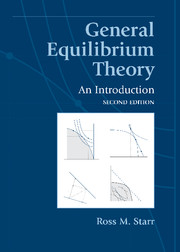Book contents
- Frontmatter
- Contents
- List of illustrations
- Introduction to the second edition
- Preface to the second edition
- Preface to the first edition
- Table of notation
- Table of assumptions
- A General equilibrium theory: Getting acquainted
- B Mathematics
- 6 Logic and set theory
- 7 RN: Real N-dimensional Euclidean space
- 8 Convex sets, separation theorems, and nonconvex sets in RN
- 9 The Brouwer Fixed-Point Theorem
- C An economy with bounded production technology and supply and demand functions
- D An economy with unbounded production technology and supply and demand functions
- E Welfare economics and the scope of markets
- F Bargaining and equilibrium: The core
- G An economy with supply and demand correspondences
- H Standing on the shoulders of giants
- Bibliography
- Index
6 - Logic and set theory
from B - Mathematics
Published online by Cambridge University Press: 05 June 2012
- Frontmatter
- Contents
- List of illustrations
- Introduction to the second edition
- Preface to the second edition
- Preface to the first edition
- Table of notation
- Table of assumptions
- A General equilibrium theory: Getting acquainted
- B Mathematics
- 6 Logic and set theory
- 7 RN: Real N-dimensional Euclidean space
- 8 Convex sets, separation theorems, and nonconvex sets in RN
- 9 The Brouwer Fixed-Point Theorem
- C An economy with bounded production technology and supply and demand functions
- D An economy with unbounded production technology and supply and demand functions
- E Welfare economics and the scope of markets
- F Bargaining and equilibrium: The core
- G An economy with supply and demand correspondences
- H Standing on the shoulders of giants
- Bibliography
- Index
Summary
Let us review some basic elements of set theory:
Logical inference In mathematical logic the word implies means “leads to the logical inference that” and can be represented by the symbol of the double shaft arrow, ⇒. This represents a strong causal relation.
Definition of a set We think of a set as a group or collection, defined by the items in the collection. A typical set might consist of all UCSD freshmen, all surfers in Southern California (there is obviously some overlap here), or the positive integers between 1 and 10. We might call a set by another name, such as a collection, a family, a class, an aggregate, or an ensemble. We use the notation of a pair of braces, { }, to denote a set. We can use a description of elements of the set to define the set. Thus, the entity denoted {x | x has property P} is the set of all things with property P (whatever that is). The set of positive integers between 1 and 10 can be expressed then as {1, 2, …, 9, 10} or, equivalently, as {x | x is an integer, 1 ≤ x ≤ 10}.
Elements of a set The elements of a set are the things in the collection. If x is an element of the set A, we write x ∈ A.
Information
- Type
- Chapter
- Information
- General Equilibrium TheoryAn Introduction, pp. 69 - 74Publisher: Cambridge University PressPrint publication year: 2011
